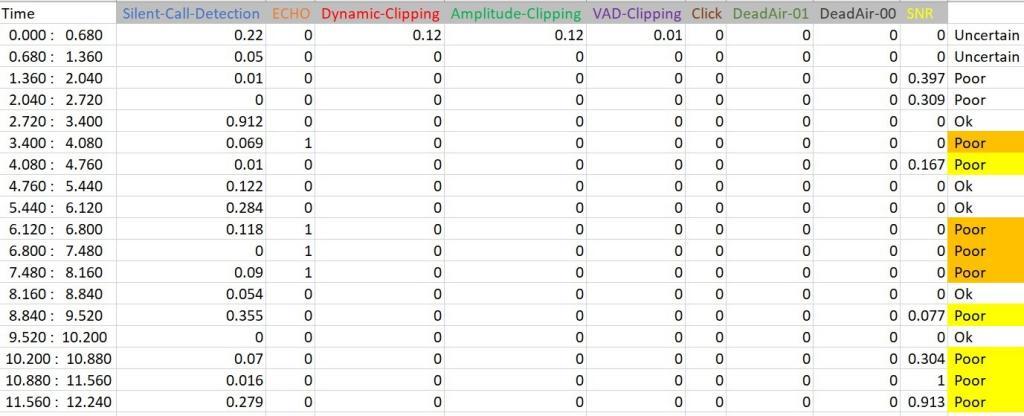Do you want to compare reference and test audio to evaluate the quality in your own language, but don’t have a tool?
AQuA is an audio quality analyzer that gives you even more flexibility:
✔️Language Independence – AQuA can evaluate quality of audio in any language.
✔️Long and short calls support – analyzes audio shorter than 4 seconds and longer than 30 seconds.
✔️Works with Stereo Audio – test signals may be mono or stereo, narrow, wideband and super wideband.
✔️Allows parameters profiling – configurable perceptual model that best suits your test environment.
Are you into conversational analysis?
Do you have millions of call recordings that you like to range based on audio quality?
Sevana PVQA is the tool that can analyze hours of recorded audio in a couple of minutes.
Request a call with our team to learn more about call recordings quality analysis and other related technologies for audio quality assessment.
Sevana QualTest is a mobile testprobe GSM VoIP application that checks current network conditions and estimates voice quality in mobile and VoIP networks. The platform is designed for end-to-end and single-end call testing, as well as for gathering and analyzing call audio quality metrics. Measure network metrics for VoIP calls and use waveform analysis to correlate audio problems with network conditions.
QualTest mobile test probe is an application for Android-powered devices that can work in both VoIP and cellular networks. A powerful tool for end-to-end and single-ended call testing. Fully functional frontend allows easy set up of tests specifying calling and called parties, reference audio and devices. Reporting shows overall quality MOS scores throughout different time periods, successful and failed test calls and speech-to-text engine provides information on call audio contents. The system works perfectly with unrooted and rooted mobile phones and analysis can be performed as on mobile device itself as well as on the devices it is connected to (e.g. Raspberry Pi in case of regular unrooted phones).
Being a multipurpose tool for voice quality analysis PVQA Server can be the core of a quality analysis and monitoring system to detect and investigate QoE and QoS related issues. PVQA Server combines the force of audio waveform analysis using PVQA technology with continuous network monitoring:
🔎Real-time call quality monitoring
🔎Proactive maintenance based on non-intrusive waveform analysis
🔎Monitoring network and media quality simultaneously
🔎Matching network metrics (RTT, jitter, latency, packet loss) with payload metrics (noise, clipping, dead air, echo etc)
Voice quality is the term used to describe the clarity of your voice. It’s more than just the sound of your voice—it also includes things like background noise and interference, which can have an adverse effect on how well your voice is heard. This makes passive voice quality testing and analysis and important part of modern communications.
Sevana AQuA and PVQA libraries collect all the data related to impairments that may affect voice quality in real-time providing immediate alerting and storage of all metrics related to call audio degradation. Audio impairments one can map on network parameters (jitter, packet loss, RTT delay) that will form patterns related to certain routes, destinations, originations. Every call analyzed by the system creates data that one can study using bigdata analysis tools to predict network behavior and call quality.

Silent Call – one leg of the voice call has no speech
Echo – this is typically due to a blockage or mismatch, which results in the signals bouncing back from where they came. Additionally, the presence of echo effect in packet switched networks can be traced back to the functionality of the line. Where standard lines function with a delay of 10 milliseconds, packet switched networks can have up to 400 milliseconds of delay. As a result, the echo effect is much more noticeable.
Amplitude clipping – is typically a result of a misconfigured voice gateway on the voice path.
Dynamic clipping – notifies about possible clipping happening in another network as the audio waveform looks like amplitude clipping, however, it is not present at the moment.
VAD clipping – this impairment detects incorrect work of Voice Activity Detector (VAD). Detector finds edges of active and inactive fragments of the signal considering VAD worked too late (in the beginning of the speech) or too early (in the end of the speech).
Click – is a single energy spike in the spectrum of the audio, which may happen for different reasons.
DeadAir-01 – is a zero-signal level inside speech, a gap in speech that may be caused by different reasons.
DeadAir-00 – is a constant signal level inside speech and may have positive and negative value.
SNR – this means that noise level present in the call affects human perception and disturbs the caller.
Within impairments analysis one can not only detect impairments that degraded voice quality in real-time, but in case of post call analysis pinpoint actual time period when certain impairment took place (as it is specified on the picture, Poor intervals are marked with the same color the impairment detectors that triggered the problem, e.g. Echo)
Further more, big data analysis of reports generated by PVQA help to identify impairment patterns specific for certain problems in the networks, e.g.
Click + DeadAir-01 – high probability that packet loss affected the call audio
Click + VAD clipping – possible packet loss
Contact us to have full demo on PVQA analysis or PVQA Server functionality.
 Network operators may reduce network operations costs by up to 65% using automation at the IP domain layer. Analysys Mason partnered with Nokia to conduct in depth operator interviews to reach this conclusion. We believe that one can significantly reduce costs also on test automation and call quality monitoring using Sevana QualTest and PVQA Server.
Network operators may reduce network operations costs by up to 65% using automation at the IP domain layer. Analysys Mason partnered with Nokia to conduct in depth operator interviews to reach this conclusion. We believe that one can significantly reduce costs also on test automation and call quality monitoring using Sevana QualTest and PVQA Server.
We would like to announce pre-release of new versions of AQuA and PVQA that introduce Machine Learning engine integrated into both technologies. With these new tools our customers now can train perceptual models of AQuA and PVQA to provide MOS (Mean Opinion Score) scores that better conform real user quality of experience. Please contact us for demonstration and evaluation.
Register to our webinar on how to measure caller’s quality of experience (QoE).
This time we’ll show how to setup an end-to-end call quality testing and monitoring in mobile networks.
We’ll present and discuss QualTest GSM, show how one can turn an ordinary Android smartphone into a mobile test probe, demonstrate standard (3G / 4G / 5G) agnostic end-to-end test calls, and how the QoE metrics are collected and aggregated by QualTest solution.
